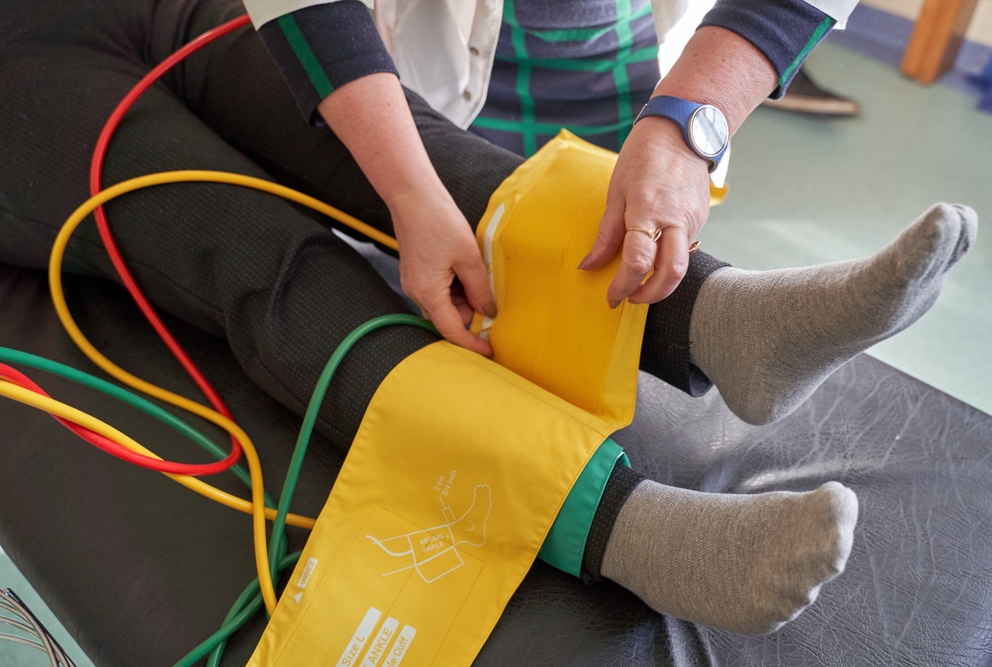In patients with severe artery blockage in the lower leg, an artery-supporting device called a resorbable scaffold is superior to angioplasty, which has been the standard treatment, according to the results of a large international clinical trial co-led by researchers at Weill Cornell Medicine and NewYork-Presbyterian.
Angioplasty involves the widening of a narrowed artery with a small, balloon-like mechanism. A resorbable scaffold is a stent-like structure that props the artery open but is biodegradable and dissolves within a few years, avoiding some of the potential complications of a permanent stent.
In the clinical trial, as reported Oct. 25 in the New England Journal of Medicine, the researchers compared the insertion of a resorbable scaffold—imbued with a drug to reduce the chance of re-blockage—to standard angioplasty in 261 patients with severe artery disease below the knee. They found that 74 percent of the patients who received the resorbable scaffold avoided a bad outcome such as leg amputation or new artery-opening intervention in the year after the procedure, compared with 44 percent of patients who underwent angioplasty.
"If approved, this device has the potential to change clinical practice and save many patients’ limbs,” said study co-senior author Dr. Brian DeRubertis, chief of vascular and endovascular surgery at Weill Cornell Medicine and NewYork-Presbyterian/Weill Cornell Medical Center.
The other leaders of the study were Dr. Sahil Parikh, associate professor of medicine at the Columbia University Vagelos College of Physicians and Surgeons, and director of endovascular services at NewYork-Presbyterian/Columbia University Irving Medical Center; and Dr. Ramon Varcoe, associate professor at the University of New South Wales and director of the Vascular Institute at the Prince of Wales Hospital in Sydney, Australia.
A scarcity of good treatments
Peripheral artery disease is similar to coronary artery disease but involves the narrowing or blockage of arteries in the limbs, usually the legs. It has the same major risk factors as other forms of vascular disease, namely smoking, aging, diabetes, high blood cholesterol levels and lack of exercise. The condition is also very common, affecting an estimated seven to twelve million people in the United States alone.
The most severe form of peripheral artery disease, known as chronic limb-threatening ischemia (CLTI), involves such an insufficiency of blood flow that patients feel pain in the affected limb even when at rest. Patients with CLTI often develop non-healing wounds and ulcerations, which can require amputation or cause fatal infection. CLTI has been particularly hard to treat successfully when the affected arteries are below the knee; in recent years, multiple clinical trials of stents and other proposed new interventions for below-knee CTLI have failed to show a benefit over angioplasty.
“Apart from angioplasty, which is a more than 40-year-old technology, we haven’t had a lot of treatment options for CLTI below the knee,” Dr. DeRubertis said.
Resorbable scaffolds that slowly release inflammation-suppressing compounds are already used to treat coronary artery blockages, and some initial studies have suggested that they might be more effective than angioplasty for lower-leg artery disease. Scaffolds provide direct mechanical support to diseased arteries for much longer, compared to angioplasty. They also dissolve eventually, unlike permanent stents which can accelerate artery re-blockage by their long-term contact with artery walls and can complicate future interventions.
A big difference in outcomes
The new trial, sponsored by Abbott Vascular, compared the company’s resorbable, drug-releasing scaffold with standard angioplasty at 50 vascular surgery centers, including NewYork-Presbyterian/Weill Cornell Medical Center, in the United States, Australia, New Zealand, Hong Kong, Singapore and Taiwan. Of the 173 CLTI patients randomly assigned to receive the scaffold, 135 were able to avoid amputation, new total blockage of the affected artery, and other pre-defined adverse events in the year after the procedure, compared with 48 of the 88 angioplasty patients. A standard statistical analysis accounting for differences in event times suggested that the scaffold group had a 74 percent chance of avoiding these adverse events for the first year, whereas the angioplasty group had a 44 percent chance—a 30 percentage point difference.
“That’s a very big difference for this type of trial,” said Dr. DeRubertis, who was recruited as professor of surgery at Weill Cornell Medicine.
Scaffold insertion also appeared to be as safe as angioplasty, in terms of procedure-related complications.
Dr. DeRubertis noted that, unlike some clinical trials, this one enrolled patients from a relatively diverse set of ethnic backgrounds, making it more likely that its results are broadly applicable.
As the researchers noted in their paper, the study had some limitations including the fact that patients on average had shorter areas of arterial blockage than the typical patient with below-the-knee CTLI. Nevertheless, Dr. DeRubertis said that he expects the findings to lead to Food and Drug Administration approval of the scaffold device.
Many Weill Cornell Medicine physicians and scientists maintain relationships and collaborate with external organizations to foster scientific innovation and provide expert guidance. The institution makes these disclosures public to ensure transparency. For this information, see the profile for Dr. Brian DeRubertis.

